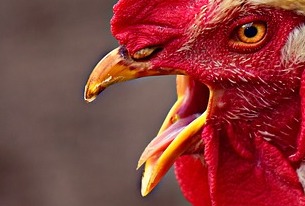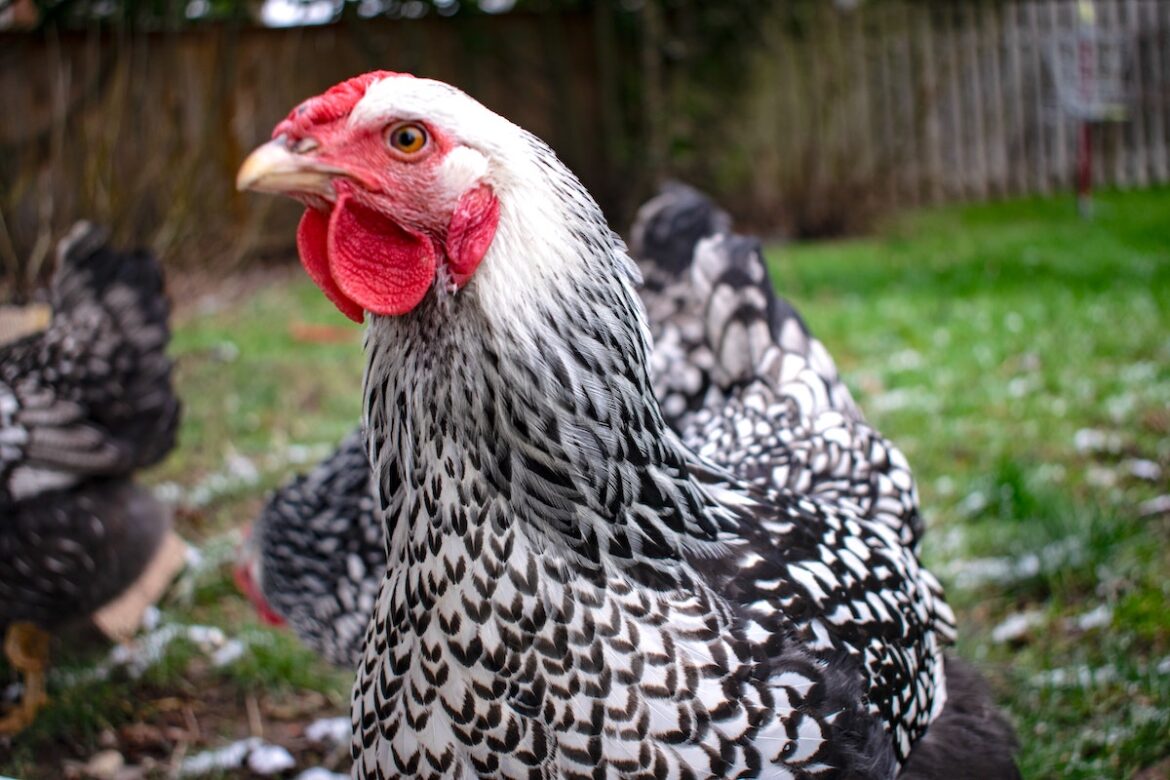It’s not often that you find yourself staring into the beak of a chicken, and this could lead to you having some questions as to what’s going on in there. Chickens peck around at their food all day long on the ground, and it might leave you wondering exactly how the inside of a chicken’s beak works.
Do chickens have a tongue? Chickens do have tongues! They are a little smaller than the size of their beak and play quite an important role in how chickens eat. You won’t be able to see a chicken’s tongue unless you get a good look into their mouth, but it is definitely there!
We have gathered up all the information you need on a chicken’s tongue, why they have them, what they look like, and some other interesting information, either to quell your interest or to help you better understand your own chickens at home!
What A Chicken’s Tongue Looks Like

Much like a chicken’s ears, their tongue is hidden away from sight.
There is very little chance that your chicken will stick their tongue out at you, and the only way you will get to see the tongue of a chicken is by getting up real close and having a look into its mouth. Luckily, we’ve found a picture for you here.
A chicken’s tongue is vital to help them eat properly, and is designed to help with specific functions. Size-wise, a chicken’s tongue is just slightly smaller than the lower beak. It fits comfortably into the lower beak space and ends in a pointed tip.
It looks pretty much how you would expect it to look, similar to any other tongue, just much smaller! The color of a chicken’s tongue can vary, but most commonly the color of the tongue matches the color of the rest of the chicken’s mouth.
The texture of the tongue is similar to very fine sandpaper, with little bumps or barbs along the surface. The texture is actually very similar to the texture of a cat’s tongue, quite rough and with the ability to grip onto something quite well.
While there are many different breeds of chickens, they mostly share the same form and size of tongue, with the larger birds having more space to accommodate larger tongues. The color of the tongue will also depend on the breed of chicken and the color of their mouths.
Why Do Chickens Have Tongues?
Tongues serve quite important purposes for chickens, and without them, they would battle to eat and go about their usual day-to-day functions.
Much like humans, chicken’s tongues help them to taste the food they are eating. They also help them manipulate their food, picking up and latching onto bugs and worms, and also make some unique chicken sounds. Here are some of the main functions of a chicken’s tongue.
1. Eating
Chickens eat by pecking around at their food, whether it is chicken feed scattered on the ground, or worms just below the surface of the soil. Their beak helps with pecking and picking up any food on the ground, but once the food is in the beak, the tongue does the rest of the work.
The tongue helps to manipulate the food in the chicken’s mouth, and push the food to the back of the throat. Once swallowed, the food ends up in the gizzard, which is the first stomach. The barbs on the tongue help to keep the food controlled in the mouth, and make sure all of it is pushed backward to be swallowed.
Without a tongue, chickens would be able to peck up the food with their beaks and have the food in their mouth, but they would not be able to swallow it, so their tongues are vital in eating and swallowing.
2. Tasting
Just like humans, a chicken’s tongue has taste buds that help them taste the food they are eating. Their taste buds are not as developed as a humans, or certain other animals, but it still gives them the ability to taste the food that they are eating, which helps them decide how edible the food is.
While chickens have some taste buds on their tongue, most of their taste buds are found in their oral cavity, which allows more space for these taste buds to be found, as their tongues are considerably small.
Chickens have the ability to taste sweet foods, but they cannot detect spiciness. This is why they will happily peck away at peppers, no matter how hot, as they cannot taste the fiery spiciness that we can! So even though chickens do have taste buds, it is not the most important function that their tongue has to offer.
3. Making Sounds
A chicken’s tongue does help it to make some distinctive sounds, but it is not flexible or large enough to make a wide range of noises. Parrots, for example, have flexible and longer tongues, which allow them to display a wide range of sounds, and even give them the ability to talk.
However, the tongue does help chickens to vocalize and make some noises, which is an important part of how they interact with each other.
Do Chicken Tongues Have A Nail On The Tip?
A chicken’s tongue has a special little feature – the lingual nail. The lingual nail is formed through the process of keratinization, which is where cells become filled with the protein keratin, and which results in structures such as nails and feathers.
This lingual nail on the tip of a chicken’s tongue helps to lift up small grains and food. It is slightly flexible and works similar to a spoon, scooping and lifting up small items into the chicken’s beak as they peck around at food on the ground. This ensures that more food is placed into the chicken’s mouth at one time and that they can easily pick up more food in one go.
Do Chickens Use Their Tongue To Drink?
Many animals use their tongue to drink water, scooping and lapping water up with their tongue and bringing it to their mouth. Chickens do not do this, and their tongue really does not play any role when drinking water. Their tongue is too small for this and is not flexible enough to scoop and cup water.
Chickens drink by opening and closing their mouth quickly in water, trapping the water inside their beak. Once this water is trapped in their beak, they tip their head back and then swallow the water.
It does seem like an awfully tiresome way to drink water, but it is a fairly common way for birds to drink, even though many birds could use their tongues to scoop up water.
Can A Chicken Stick Out Its Tongue?
You will never see a chicken sticking out its tongue. This isn’t for a lack of trying; their tongues are just way too short and inflexible to be pulled outward.
To fit inside their beaks, and still leave enough room for eating and drinking, a chicken’s tongue needs to be small and not get in the way, which means that their tongues are not able to be stuck out and maneuvered like many other animals.
Related Questions
To recap, chickens do have tongues. Although their tongues are small and not very flexible, they are vital in helping chickens eat and swallow food.
The movement of their tongues is limited, and they aren’t able to use their tongues to drink or make a wide range of noises, but without them, they would not be able to swallow their food or scoop up little pieces of grain.
So now that you know all about chicken tongues, it’s time to answer a few related questions!
Do Chickens Have Teeth?
Chickens do not have teeth. There is no need for chickens to have teeth, as they do not need to grind up food in their mouth. When they peck up food with their beak and swallow it using their tongue, the food is pushed to their first stomach, called the gizzard.
This gizzard grinds up the food, which makes it easier to digest. Chickens also eat grit for this reason, which, along with strong muscular movements of the stomach, breaks up and grinds food. Chickens do not need teeth to eat, so there is no reason for them to have any.
Can Chickens Smell?
Chickens do not have a strong sense of smell. Their nostrils can pick up on a few scents, but their sense of smell is not sensitive enough that they would turn their nose up at bad odors. This also goes hand in hand with their limited taste buds.
How Many Taste Buds Does A Chicken Have?
Chickens only have around 240 to 360 taste buds, which means that they have a very limited sense of taste. For this reason, you can easily feed your chickens some hot chili peppers and they will happily peck away at them without any reaction!
Up Next: Why Do Chickens Have Wings? – Everything You Need To Know
